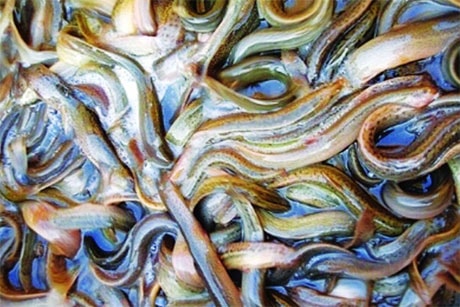Loach farming - A new and promising direction
The mud loach (Misgurnus anguillicaudatus Cantor) belongs to the loach family (Cobitida); is a freshwater aquatic species; in addition to domestic consumption, it is also exported.
Biological characteristics
Loach has a round body, flattened on the sides, especially near the tail; when mature, it is about 15cm long. The head is small, slightly round, the eyes are small, the mouth is low and has whiskers. The skin is thin, with many sebaceous glands under the skin, making it very smooth. The scales are small, lying deep under the skin so they are difficult to see, leading many people to think that loaches have smooth skin and no scales. The dorsal fin has no hard spines; the pectoral and pelvic fins are short; the caudal fin is wide.
Mud loach
The fish is yellow, brown or dark gray, the back is darker than the belly. There are many dots on the body, each dot is made up of many small dots. At the base of the caudal fin, there is a large black dot, on the fin there are many parallel black stripes. Loach is commonly used as food or used as medicine (fish, fishing...). In recent years, due to high demand, in our country, the profession of raising commercial loaches has appeared. Currently, in many places such as Hanoi, Nam Dinh, Hai Duong... people are developing the profession of raising loaches because it both takes advantage of ineffective agricultural land areas and brings economic benefits.
Short and effective rearing time
For wild-caught breeds, only buy those that are caught by nets, traps or hand-catch, not those caught by electricity. The breeds are uniform, without scratches, slime loss or deformities. When buying from a hatchery, the breeds must be "pure" to the water of the commercial farm, to avoid the phenomenon of the breeds being shocked by water.
Loach breed
The environment for raising loach fish must ensure the following conditions: water level not exceeding 40cm, in the pond there must be ditches 50 - 60cm deep for loach to hide. When raising in the field, the mud bottom must be clean, the field needs to be fertilized with compost before planting rice to create natural food for loach. For raising in ponds, it is necessary to add water hyacinth to create shelter for loach and keep the water environment clean. Loach fish can eat many types of food (animals, plants), feed the fish enough food (5 - 8% of body weight), put food in the net for the fish to eat and check for excess food to avoid pollution.
If you raise loach fish properly, after 4 months of raising, you can harvest them at a size of 40 - 50 fish/kg. The price ranges from 80,000 - 100,000 VND/kg, or even 120,000 - 150,000 VND/kg depending on the season.
In our country, in addition to mud loach, there is also river loach (chac lau). The body of the chac lau is larger than that of the mud loach, and its back has a row of spines. The chac lau species is also being researched, the process of seed production and commercial farming is being perfected, in the future it can be widely farmed, reducing the pressure of exploiting natural river loach.
According to (Vietnam Fisheries) - LY






